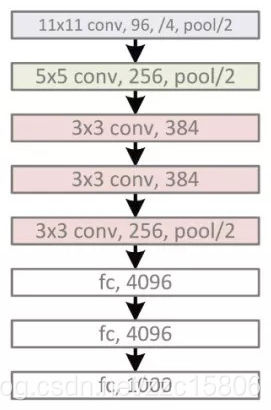简介
Alexnet是2012年ImageNet比赛的冠军Hinton及其学生Alex Krizhevsky提出,并以其姓名命名的网络。Alexnet的提出也正式掀起了深度学习的热潮,激发了研究者对深度学习的热情。虽然后面出现了更为优秀的VGGNet、GooLeNet、ResNet等网络,但是Alexnet的地位是不可撼动的,因此我们有必要去花些时间了解一下这一深度学习史上的伟大杰作。
Alexnet论文链接:http://papers.nips.cc/paper/4824-imagenet-classification-with-deep-convolutional-neural-networks.pdf
网络结构

上图为论文中的网络结构图。因为论文中使用了两块GPU进行训练,所以有两个分支。为了使网络结构看起来更加直观,将网络结构简化为下图,

Alexnet共包含5个卷积层和3个全连接层,其中第1,2,5个卷积层后接最大池化和LRN操作。
主要贡献
1. 使用ReLU代替Sigmoid作为激活函数,成功解决了Sigmoid在网络较深时的梯度弥散问题;
2. 最后几个全连接层使用Dropout,避免过拟合;
3. 使用了重叠最大池化操作,即池化步长比池化核尺寸小,提升了特征的丰富性。此前CNN普遍采用平均池化,最大池化能够避免平均池化的模糊化效果;
4. 提出了LRN层。LRN全称Local Response Normalization,对局部神经元创建竞争机制,增大响应大的单元,抑制反馈小的神经元,增强了模型的泛化能力。(VGGNet没有使用LRN,作者表示LRN对模型没有提升,而且参数量大,当然不能以偏概全);
5. 使用CUDA利用GPU加速深度卷积网络的训练。
6. 数据增强。通过随机裁剪、旋转、翻转等操作,减轻过拟合,提升模型泛化性能。
代码实现
本文使用Keras实现Alexnet网络。
from keras.layers import Input
from keras.layers import Conv2D, MaxPool2D, Dense, Flatten, Dropout, Lambda
from keras.models import Model
from keras import optimizers
from keras.utils import plot_model
from keras import backend as K
def LRN(alpha=1e-4, k=2, beta=0.75, n=5):
"""
LRN for cross channel normalization in the original Alexnet
parameters default as original paper.
"""
def f(X):
b, r, c, ch = X.shape
half = n // 2
square = K.square(X)
extra_channels = K.spatial_2d_padding(square, ((0, 0), (half, half)), data_format='channels_first')
scale = k
for i in range(n):
scale += alpha * extra_channels[:,:,:,i:i+int(ch)]
scale = scale ** beta
return X / scale
return Lambda(f, output_shape=lambda input_shape: input_shape)
def alexnet(input_shape=(224,224,3), nclass=1000):
"""
build Alexnet model using keras with TensorFlow backend.
:param input_shape: input shape of network, default as (224,224,3)
:param nclass: numbers of class(output shape of network), default as 1000
:return: Alexnet model
"""
input_ = Input(shape=input_shape)
x = Conv2D(96, kernel_size=(11, 11), strides=(4, 4), activation='relu')(input_)
x = LRN()(x)
x = MaxPool2D(pool_size=(3, 3), strides=(2, 2))(x)
x = Conv2D(256, kernel_size=(5, 5), strides=(1, 1), activation='relu', padding='same')(x)
x = LRN()(x)
x = MaxPool2D(pool_size=(3, 3), strides=(2, 2))(x)
x = Conv2D(384, kernel_size=(3, 3), strides=(1, 1), activation='relu', padding='same')(x)
x = Conv2D(384, kernel_size=(3, 3), strides=(1, 1), activation='relu', padding='same')(x)
x = Conv2D(256, kernel_size=(3, 3), strides=(1, 1), activation='relu', padding='same')(x)
x = MaxPool2D(pool_size=(3, 3), strides=(2, 2))(x)
x = Flatten()(x)
x = Dense(4096, activation='relu')(x)
x = Dropout(0.5)(x)
x = Dense(4096, activation='relu')(x)
x = Dropout(0.5)(x)
output_ = Dense(nclass, activation='softmax')(x)
model = Model(inputs=input_, outputs=output_)
model.summary()
opti_sgd = optimizers.sgd(lr=0.01, momentum=0.9, nesterov=True)
model.compile(loss='categorical_crossentropy', optimizer=opti_sgd, metrics=['accuracy'])
return model
if __name__ == '__main__':
model = alexnet()
plot_model(model, 'Alexnet.png', show_shapes=True) # 保存模型图